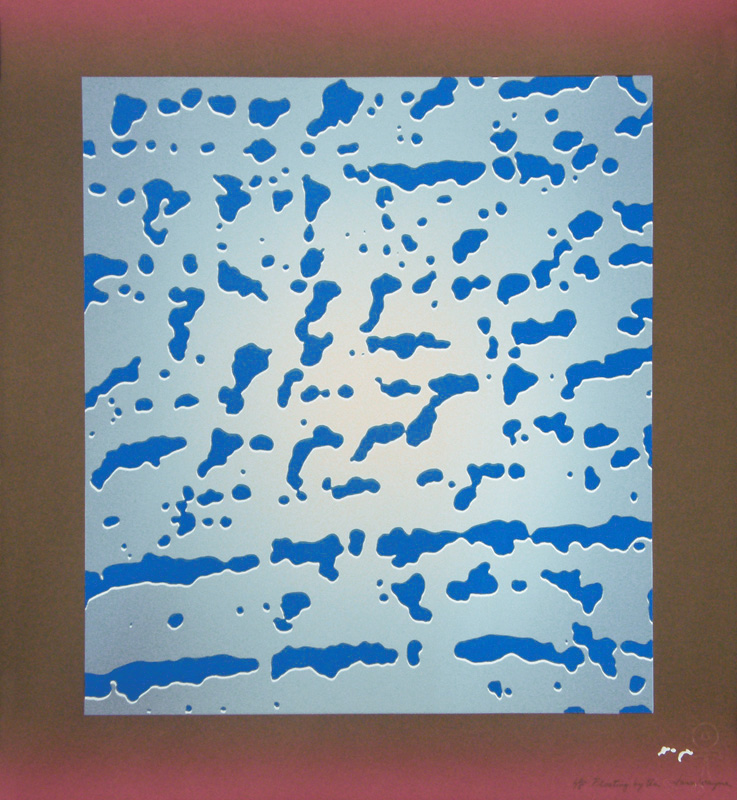Floating by Ten is color lithograph created in 1978 by American artist June Wayne. It is pencil signed, titled and editioned 10/15. It was printed by Edward Hamilton on Wayne’s own Rives with Tamstone watermark. Floating by Ten is a nine-color lithograph printed from four aluminum plates and the reference is Conway 298. Both the image and paper measure 24-12 x 22-1/2 inches.
By 1978 June Wayne had been working in lithography for thirty years and she was now developing a variety of series that meditated on her personal politics, the notion of identity and privacy, and her personal studies in DNA, tidal forces, and physics.
This same year, she had nearly completed her semi-biographical set of twenty lithographs dedicated to the life of her mother, the Dorothy Series, as well as the Visa Series, which explored self-identity through the image of the fingerprint. Interspersed throughout these works were her interpretations of macro and micro theoretical physics. "Floating by Ten" inadvertently acts as a culmination of these subjects: the shapes found "floating" in a square of pale blue could be a depiction of late evening clouds, or a fingerprint, or minute biological forms enlarged by a microscope. Wayne commented on these series: “In these cosmic images I started using the convention of a field and a detail, in this case enormously enlarged, a little tiny fragment, enlarged and simplified, until it becomes a kind of calligraphy.”
June Claire Wayne, painter, printmaker, educator, and administrator, was born in Chicago, Illinois on 7 March 1918. She was primarily self-taught as an artist and had her first exhibition at the Boulevard Bookshop in Chicago in 1934 at age seventeen.
The
following year her first major exhibition was mounted at the Palacio de Bellas
Artes in Mexico City. Wayne moved to New York City in 1939, where she worked in
the garment industry, an endeavor that continued to inform her work throughout
her career. With the advent of World War II, she traveled to California where
she studied technical drawing at the California Institute of Technology in
Pasadena. After a brief return to Chicago where she worked in the WPA program
and wrote for a radio station, she moved to Los Angeles in 1946.
In 1948, Wayne attended Lynton Kistler's lithography classes in Los Angeles,
working in his studio on numerous occasions. Dissatisfied with the limitations
of the workshop, Wayne traveled to Paris in 1957 to work with Marcel Durassier,
hoping to find the encouragement to funnel her vision of experimental fine art
lithography into a reality. Working with master printers and fine paper made it
apparent that a comparable workshop was needed in the United States. She
consulted with artist Clinton Adams in 1959 and, with a grant from the Ford
Foundation, the Tamarind Lithography Workshop was founded in Los Angeles in
1960. Adams served as the founding associate director and Wayne served as its
director. After ten years of co-operating the workshop, she arranged to hand
over the workshop to the University of New Mexico, Albuquerque, where it
remains a magnet for artists from all over the world.
Wayne then explored large-scale tapestry production at the historic Manufactory
des Gobelins in Paris. After creating designs for tapestries, Wayne worked
directly with the weavers at the factory, unlike many artists of the time who
left their projects in the hands of the institute. She also focused on oil
painting and sculpture, and often explored physics and astronomy in her subject
matter. She continued to work in color lithography and often pared down her
editions to focus on perfecting her technique.
June Wayne's experiences as a woman in the Modern art world made it obvious to
her that there was a need for representation and support for women in the arts.
Despite her outright rejection of the label “woman artist,” she created a forum
to instruct female artists how to self-promote. In 1972, Wayne held her first
seminar for aspiring women artists, curators, and directors hoping to bolster
their knowledge in navigating galleries, museums, universities and other
institutions; these events would eventually become known as the “Joan of Art”
seminars.
Wayne is ensured a niche in the history of lithography with her prolific and pioneering body of work, as well as, the Tamarind Institute. She has been honored with numerous accolades and her affiliations included memberships in the National Association of Women Artists, Society of American Graphic Artists, Philadelphia Print Club, Los Angeles Art Association, and the Society of Washington Printmakers. She participated in thousands of exhibitions in the United States and internationally. Her work is represented in numerous collections of which include the Los Angeles County Museum of Art and the University of Southern California, Los Angeles; the Museum of Modern Art, New York; the Bibliothèque Nationale de France, Paris; the Fine Arts Museums of San Francisco, California; and the Library of Congress, Washington, D.C.
June Wayne died at her home in Los Angeles on August 23, 2011.



